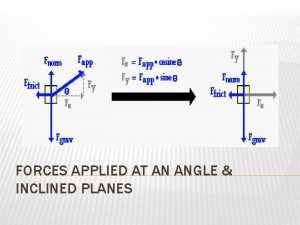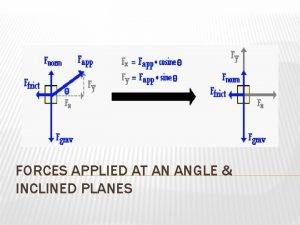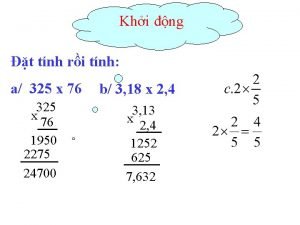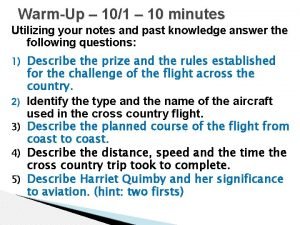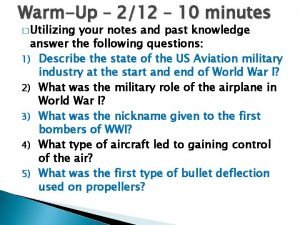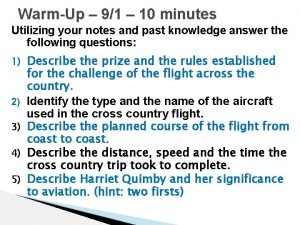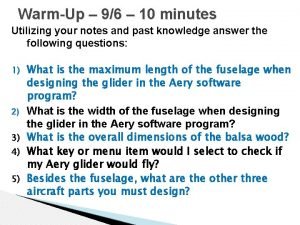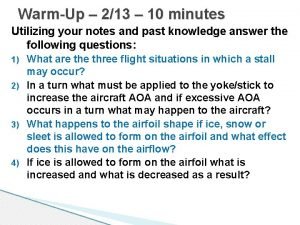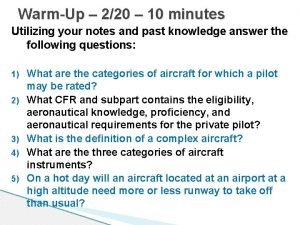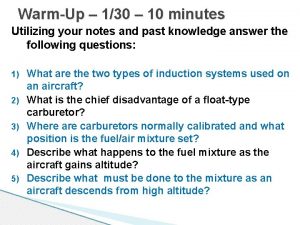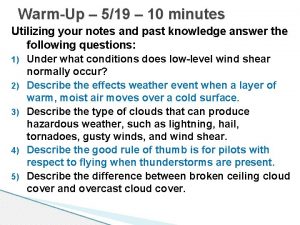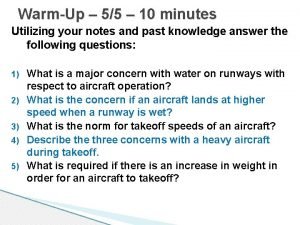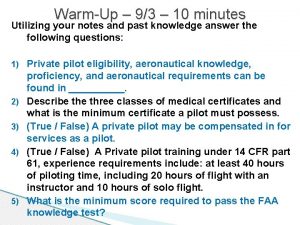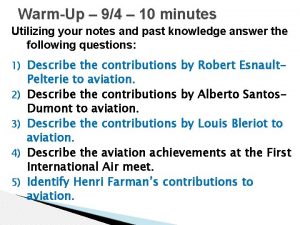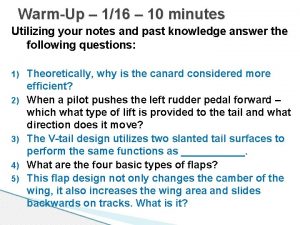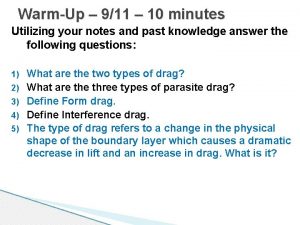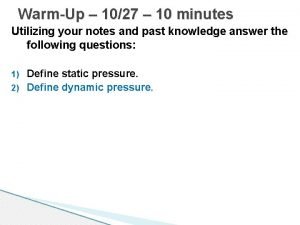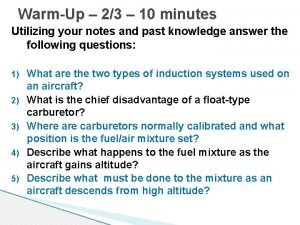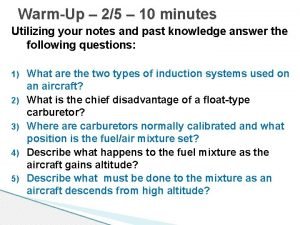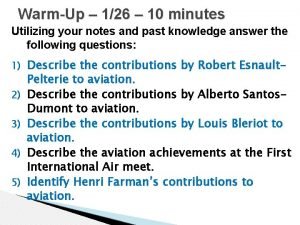WarmUp 325 10 minutes Utilizing your notes and






































- Slides: 38

Warm-Up – 3/25 – 10 minutes Utilizing your notes and past knowledge answer the following questions: 1) 2) 3) 4) 5) Describe the purpose of an altimeter. How are adjustments made to an altimeter? What is the window on an altimeter named? What does a decrease in pressure cause the altimeter to indicate? Name and describe the five types of altitude a pilot must be familiar.

Questions / Comments

Warm-Up – 3/25 – 10 minutes Utilizing your notes and past knowledge answer the following questions: 1) 2) 3) 4) 5) Describe the purpose of an altimeter. How are adjustments made to an altimeter? What is the window on an altimeter named? What does a decrease in pressure cause the altimeter to indicate? Name and describe the five types of altitude a pilot must be familiar.

Altimeter • The altimeter is an instrument that measures the height of an aircraft above a given pressure level. • Since the altimeter is the only instrument that is capable of indicating altitude, this is one of the most vital instruments installed in the aircraft.

Warm-Up – 3/25 – 10 minutes Utilizing your notes and past knowledge answer the following questions: 1) 2) 3) 4) 5) Describe the purpose of an altimeter. How are adjustments made to an altimeter? What is the window on an altimeter named? What does a decrease in pressure cause the altimeter to indicate? Name and describe the five types of altitude a pilot must be familiar.

Principle of Operation • Adjustments for nonstandard pressures are accomplished by setting the corrected pressure into a barometric scale located on the face of the altimeter.

Warm-Up – 3/25 – 10 minutes Utilizing your notes and past knowledge answer the following questions: 1) 2) 3) 4) 5) Describe the purpose of an altimeter. How are adjustments made to an altimeter? What is the window on an altimeter named? What does a decrease in pressure cause the altimeter to indicate? Name and describe the five types of altitude a pilot must be familiar.

Principle of Operation • The barometric pressure window is sometimes referred to as the Kollsman window; only after the altimeter is set does it indicate the correct altitude.

Warm-Up – 3/25 – 10 minutes Utilizing your notes and past knowledge answer the following questions: 1) 2) 3) 4) 5) Describe the purpose of an altimeter. How are adjustments made to an altimeter? What is the window on an altimeter named? What does a decrease in pressure cause the altimeter to indicate? Name and describe the five types of altitude a pilot must be familiar.

Altimeter Operation • When the aircraft climbs or descends, changing pressure within the altimeter case expands or contracts the aneroid barometer. • A decrease in pressure causes the altimeter to indicate an increase in altitude, and an increase in pressure causes the altimeter to indicate a decrease in altitude.

Warm-Up – 3/25 – 10 minutes Utilizing your notes and past knowledge answer the following questions: 1) 2) 3) 4) 5) Describe the purpose of an altimeter. How are adjustments made to an altimeter? What is the window on an altimeter named? What does a decrease in pressure cause the altimeter to indicate? Name and describe the five types of altitude a pilot must be familiar.

Types of Altitude • 1. Indicated altitude— read directly from the altimeter (uncorrected) when it is set to the current altimeter setting. • 2. True altitude—the vertical distance of the aircraft above sea level —the actual altitude.

Types of Altitude • 3. Absolute altitude— the vertical distance of an aircraft above the terrain, or above ground level (AGL). • 4. Pressure altitude— the altitude indicated when the altimeter setting window (barometric scale) is adjusted to 29. 92 "Hg.

Types of Altitude • 5. Density altitude—pressure altitude corrected for variations from standard temperature. • This is an important altitude because it is directly related to the aircraft’s performance. • The density of the air affects how much power a naturally aspirated engine produces, as well as how efficient the airfoils are.

Questions / Comments

THIS DAY IN AVIATION • March 25 • 1917 — One of the greatest fighter pilots of WWI, Canada-born Lt. Col. William Avery Bishop, scores his first combat victory over an Albatros single-seat fighter while flying a Nieuport.

THIS DAY IN AVIATION • March 25 • 1926 — Willie Messerschmitt, a graduate of Munich Technical High School and already an experienced designer of light aircraft and sailplanes, forms the Messerschmitt Flugzeugbau G. m. b. H.

THIS DAY IN AVIATION • March 25 • 1960 — The first NASA flight in the X-15 hypersonic research program gets under way when test pilot Joseph A. Walker makes the first of his flights in this aircraft.

THIS DAY IN AVIATION • March 25 • 1965 — Air National Guard received approval to display standard USAF markings on aircraft.

THIS DAY IN AVIATION • March 25 • 1993 — The first woman “Concorde” pilot makes her first flight as First Officer of the daily supersonic London-New York route. • British-born, Barbara Harmer, is one of only 17 co-pilots in the British Airways Concorde fleet.

Questions / Comments

March 2014 SUNDAY 2 MONDAY 3 TUESDAY 4 WEDNESDAY 5 Fuel Systems 9 10 THURSDAY 6 SATURDAY 8 Electrical Systems 11 12 13 Chapter 6 FRIDAY 7 Chapter 6 14 15 Flt. Line Friday Hydraulic Systems 16 17 18 19 20 21 22 Chapter 7 Pitot Static System Altimeter 23 24 25 26 27 28 29 Chapter 7 Vertical Speed Indicator Airspeed Indicator 30 31

Missing Work • 2 A • Noah Frazier – Chapter 6 Test

Missing Work • 3 A • Gerald Popp – Chapter 6 quiz 2 and Test

Questions / Comments

Chapter 7 – Flight Instruments FAA – Pilot’s Handbook of Aeronautical Knowledge

Today’s Mission Requirements • Mission: • Identify in writing how to interpret and operate flight instruments. • Describe the pilot’s ability to recognize errors and malfunctions with flight instruments. • Describe the pitot-static system and associated instruments. • Describe the vacuum system and related instruments. • Describe the gyroscopic instruments and the magnetic compass. • EQ: Describe the importance of Aeronautical Knowledge for the student pilot learning to fly.

Vertical Speed Indicator (VSI) • The VSI indicates whether the aircraft is climbing, descending, or in level flight. • The rate of climb or descent is indicated in feet per minute (fpm). • If properly calibrated, the VSI indicates zero in level flight.

Principle of Operation • Although the VSI operates solely from static pressure, it is a differential pressure instrument. • It contains a diaphragm with connecting linkage and gearing to the indicator pointer inside an airtight case.

Principle of Operation • The inside of the diaphragm is connected directly to the static line of the pitot-static system. • The instrument case, is also connected to the static line, but through a restricted orifice (calibrated leak).

Principle of Operation • Both the diaphragm and the case receive air from the static line at existing atmospheric pressure. • The diaphragm receives unrestricted air while the case receives the static pressure via the metered leak.

Principle of Operation • inside the diaphragm and the instrument case are equal and the pointer is at the zero indication.

Principle of Operation • When the aircraft climbs or descends, the pressure inside the diaphragm changes immediately, • but due to the metering action of the restricted passage, • the case pressure remains higher or lower for a short time, causing the diaphragm to contract or expand.

Principle of Operation • This causes a pressure differential that is indicated on the instrument needle as a climb or descent.

Principle of Operation • The VSI displays two different types of information: • • Trend information shows an immediate indication of an increase or decrease in the aircraft’s rate of climb or descent. • • Rate information shows a stabilized rate of change in altitude.

Principle of Operation • If an aircraft is maintaining level flight and the pilot pulls back on the control yoke causing the nose of the aircraft to pitch up, the VSI needle moves upward to indicate a climb.

Principle of Operation • If the pitch attitude is held constant, the needle stabilizes after a short period (6– 9 seconds) and indicates the rate of climb in hundreds of fpm. • The time period from the initial change in the rate of climb, until the VSI displays an accurate indication of the new rate, is called the lag.

Questions / Comments
 60 secondes 1 minute
60 secondes 1 minute Active listening vs hearing
Active listening vs hearing Defensive back tackling drills
Defensive back tackling drills Warmup ratio
Warmup ratio Warmup 65
Warmup 65 Gmass warmup
Gmass warmup Status vs class
Status vs class Surface area warm up
Surface area warm up Monorhyme
Monorhyme Properties of exponents
Properties of exponents Java warmup
Java warmup Define:warmup
Define:warmup Ethos warmup
Ethos warmup Tom schwartz tinman
Tom schwartz tinman Warmup 65
Warmup 65 Warmup end
Warmup end Confirm your email now and get 5 minutes as a gift!
Confirm your email now and get 5 minutes as a gift! Ece 325
Ece 325 Apes 325 template
Apes 325 template Infs 325
Infs 325 Semdr communication model
Semdr communication model Infs 325
Infs 325 Cse 325
Cse 325 Council of nicea 325
Council of nicea 325 Un hacendado compro caballos y vacas por 40000
Un hacendado compro caballos y vacas por 40000 What is the angle of inclination
What is the angle of inclination Article 325
Article 325 Dcma form 325
Dcma form 325 Methodology of econometrics
Methodology of econometrics Star - 325
Star - 325 A box of books weighing 325 n
A box of books weighing 325 n Cse 325
Cse 325 Cpsc 325
Cpsc 325 A307 bolt shear strength
A307 bolt shear strength 325/100 simplificado
325/100 simplificado A 325
A 325 Asteroide 326
Asteroide 326 325 ad
325 ad Cse 325
Cse 325

























